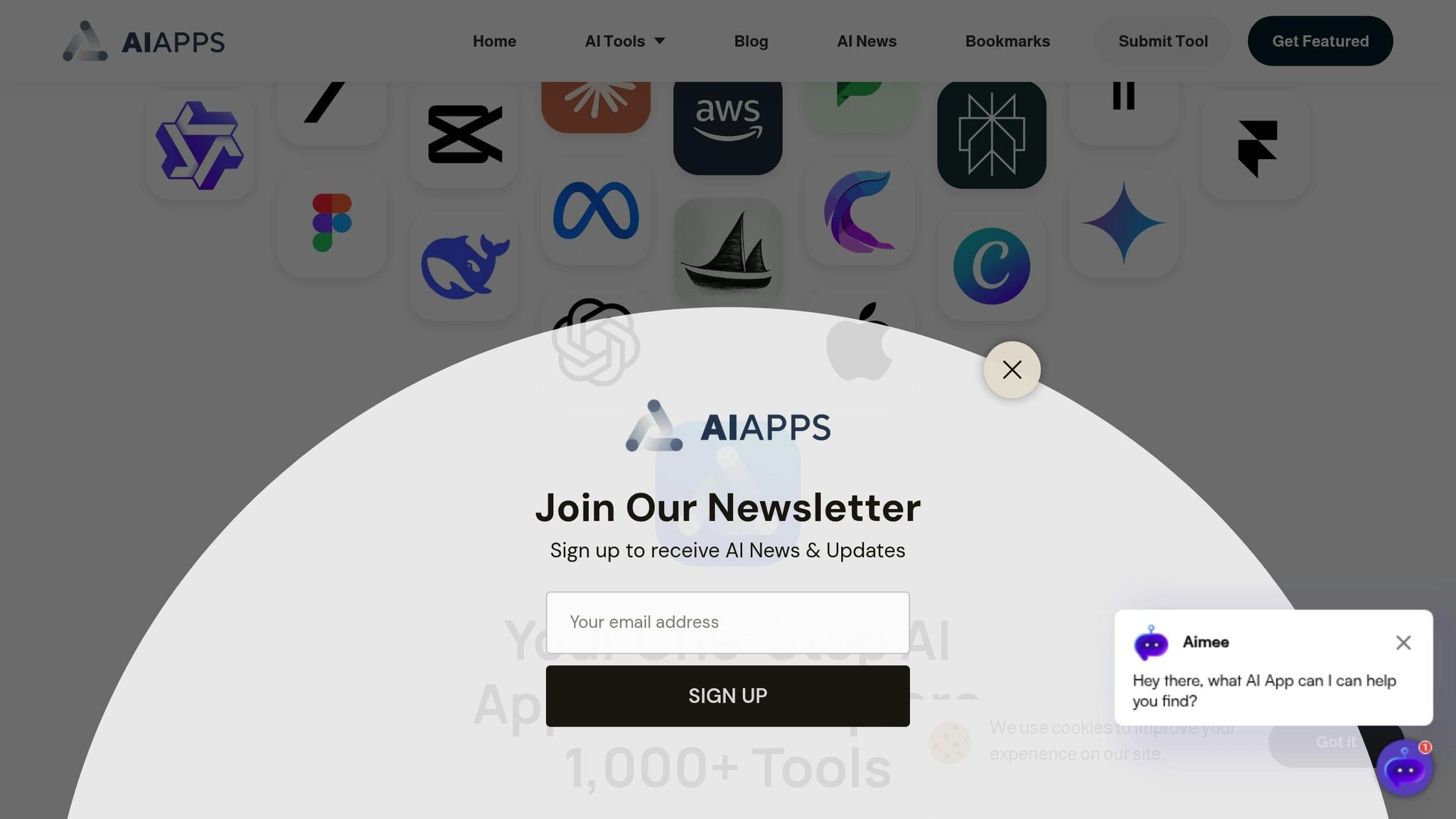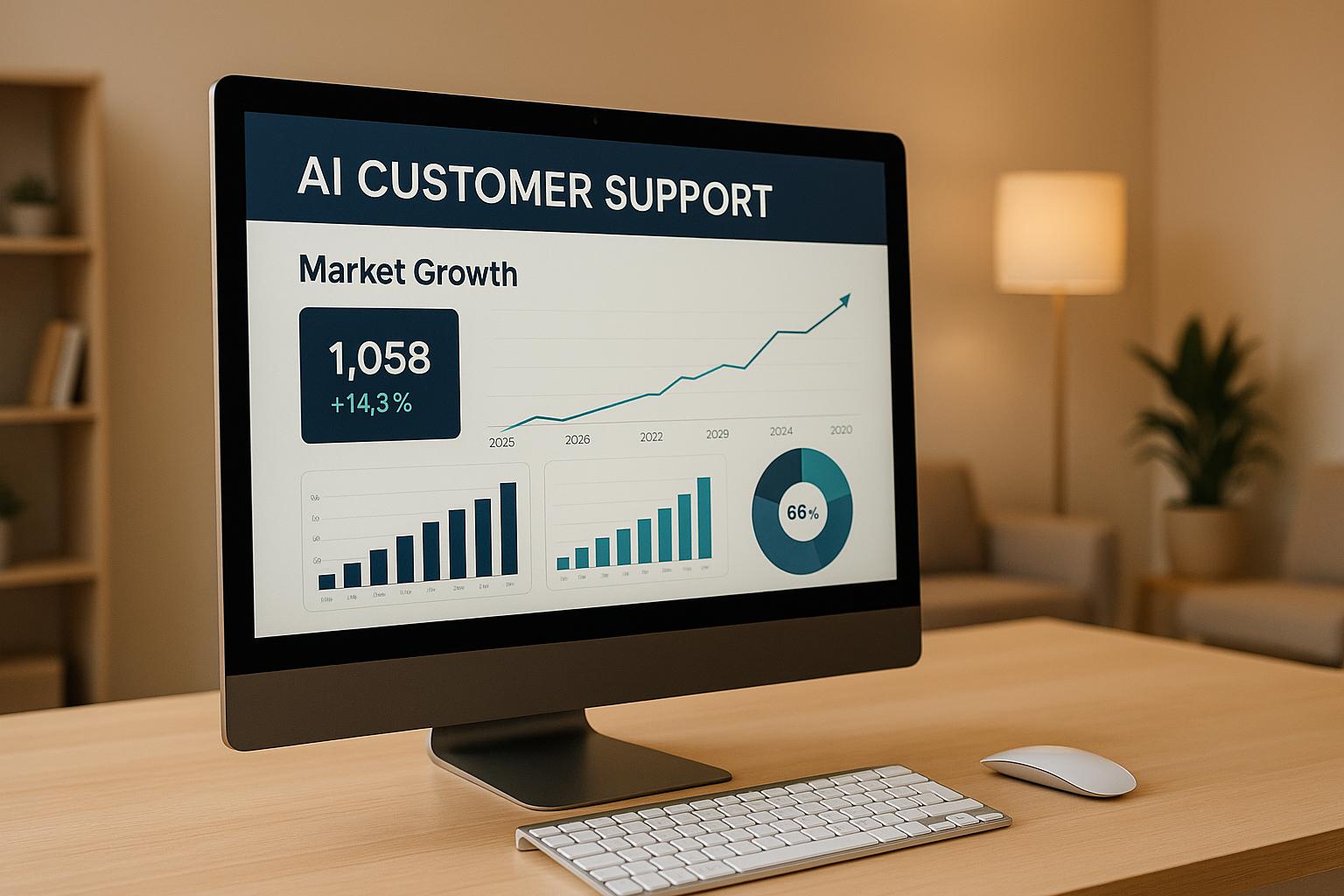When selecting an AI chatbot platform, starting with the right choice is critical to avoid costly mistakes and future disruptions. Here's what you need to know:
- Define your chatbot's purpose: Focus on a single use case - customer support, lead generation, or internal automation - before expanding capabilities.
- Plan for growth: Choose a platform that can handle your expected user volume over the next 12-18 months.
- Prioritize integrations: Ensure the platform connects with your existing tools like CRMs or help desks to avoid isolated systems.
- Evaluate language and compliance needs: Consider multilingual support, accessibility, and compliance with regulations like GDPR or HIPAA.
- Focus on usability and support: Look for user-friendly interfaces, drag-and-drop builders, strong analytics, and responsive vendor support.
- Understand costs: Compare pricing models (fixed, usage-based, hybrid) and account for hidden fees like setup, premium features, and scaling.
Pro tip: Use comparison tools like AI Apps to filter and evaluate platforms based on your specific needs.
The right chatbot can streamline operations, improve customer experience, and grow with your business. Start small, focus on your goals, and choose a platform that aligns with your long-term strategy.
6 Best AI Chatbots for Beginners in 2025
Define Your Business and User Requirements
Before diving into features and costs, take a step back and clarify your chatbot’s purpose. This crucial first step will keep you focused and help you avoid unnecessary bells and whistles that don’t serve your actual goals.
Identify the Primary Use Case
The main function of your chatbot determines everything else - from the platform you choose to the features you prioritize. For example:
- Customer support chatbots need tools like knowledge bases, ticket routing, and smooth handoffs to human agents.
- Lead generation chatbots should include workflows for qualifying prospects, CRM integrations, and nurturing potential customers.
- Internal automation chatbots help employees with tasks like accessing HR resources, submitting IT requests, or securely retrieving internal data.
Resist the temptation to create a chatbot that tries to do it all. Instead, start with one clear goal. Once your chatbot excels in its primary role, you can explore expanding its capabilities.
Also, consider your team’s ability to manage the chatbot. A complex system may require significant time for setup, maintenance, and training. Starting small and focused allows you to refine your approach before scaling up.
Determine Scalability and User Volume
Think ahead to where your business will be in the next 12 to 18 months, not just where it is today. A platform that works fine for 100 daily conversations might struggle - or even fail - if your volume grows to 10,000.
- Small businesses benefit from simple platforms with transparent pricing.
- Mid-sized companies often need advanced features like routing, analytics, and integrations that can grow with them.
- Large enterprises require robust security, extensive customization, and support for high traffic during peak times - all without performance issues or surprise fees.
Account for Language, Compliance, and Accessibility
If your audience spans different regions, remember that language support involves more than just translation. Each language comes with its own grammar, cultural nuances, and conversational styles that need to be addressed.
Compliance is another key factor. Whether it’s HIPAA, SOC 2, GDPR, or other standards, ensure the platform meets the requirements of your industry and region. Retrofitting compliance into a system later can be costly - or impossible.
Don’t forget accessibility. Built-in features that make the chatbot usable for all individuals, including those with disabilities, are essential. And think about your audience’s preferences: older users may value simplicity, while tech-savvy customers might expect advanced options. Your chatbot should feel intuitive for your specific user base.
Once you’ve clearly outlined your business needs, you’ll be in a much better position to evaluate platforms and avoid costly missteps or unnecessary complexity.
Evaluate Platform Features and Technology
Once you've outlined your requirements, it's time to assess how each platform's technical capabilities align with your needs. This involves examining the platform's language capabilities, ease of integration, and security measures. Let's break down the key areas that contribute to effective chatbot communication and seamless integration.
Assess Natural Language Processing (NLP) and AI Capabilities
At the core of any AI chatbot is its ability to understand and respond naturally to human language. Platforms with advanced language models can accurately identify user intent, maintain context during multi-turn conversations, and analyze sentiment to adjust responses or escalate issues when necessary.
For example, sentiment analysis can detect user emotions and trigger appropriate actions, such as involving a human agent or modifying the chatbot's tone to suit the situation. Multilingual capabilities are another crucial factor, as they allow the chatbot to handle regional expressions and cultural nuances - not just through basic translation but by delivering more personalized interactions.
Another important aspect is how the platform deals with ambiguous queries. A robust system should ask clarifying questions rather than defaulting to generic responses. This highlights the platform's ability to go beyond simple keyword matching and demonstrate true natural language understanding.
Check Integration and Customization Options
Seamless integration is key to ensuring your chatbot works effectively within your existing business ecosystem. The platform should connect effortlessly with tools like CRM systems, help desk software, e-commerce platforms, and internal databases. Reliable API connectivity plays a critical role here, enabling smooth data exchange while reducing development time and minimizing technical challenges.
Focus on platforms that offer native integrations with the tools you already use. Quality and reliability of these connections are far more important than having numerous superficial integrations.
Customization is equally important. Look for features like visual conversation builders that allow non-technical team members to design and tweak chat flows without coding. At the same time, support for custom code injection ensures that advanced, tailored use cases can be implemented. Custom branding options let you align the chatbot's tone, personality, and communication style with your brand identity. For customer-facing applications, white-labeling options that remove vendor branding can be particularly valuable.
Ensure Security and Ethical Standards
When handling customer data and business communications, security is non-negotiable. Choose platforms that adhere to recognized industry certifications, such as SOC 2 Type II, which confirm that the platform has undergone rigorous third-party security audits. These certifications reflect compliance with high standards for security, availability, confidentiality, and privacy.
Encryption is another critical factor - ensure the platform offers strong encryption both during data transmission and at rest. For organizations with stringent compliance needs, having options for data residency can be a significant advantage.
Ethics in AI is becoming increasingly important as chatbot technology advances. Platforms should actively work to detect and reduce bias, ensuring fair treatment for all users. Transparency features, such as notifying users that they are interacting with AI, help build trust and comply with emerging standards for disclosure.
Other important security measures include rate limiting and abuse prevention to protect resources and users. Platforms that conduct regular third-party security assessments or offer bug bounty programs demonstrate a strong commitment to maintaining security over time.
Compare Usability and Support
When choosing a platform, it’s not just about technical features. A tool’s ease of use and the support behind it can make or break its success in your organization. Even the most advanced platform won’t deliver results if your team finds it hard to use or struggles to get help when issues arise. That’s why evaluating usability and vendor support is critical to ensuring smooth implementation and long-term success.
Test Usability and Analytics Tools
A platform with a simple, intuitive interface can make all the difference. Look for tools that feature drag-and-drop conversation builders. These allow even non-technical team members to design and tweak chat flows without needing to write a single line of code. Ideally, these builders should include visual flowcharts, helping you see how conversations branch based on user inputs.
Pre-built templates are another must-have. Many platforms offer templates tailored to specific industries or use cases, such as customer support, lead generation, or appointment scheduling. These templates save time by giving you a strong starting point, so you don’t have to build chat flows from scratch.
Analytics dashboards are equally important. They help you track your chatbot’s performance and identify areas for improvement. Metrics like real-time KPIs, user sentiment, and intent analysis can significantly enhance customer satisfaction and drive conversions. For example, chatbots with 85% completion rates generate three times more conversions than those with lower engagement.
Make sure the platform’s dashboards integrate with your existing business tools and allow you to customize metrics to align with your goals. While usability is key, reliable vendor support is just as critical - let’s dive into that next.
Review Vendor Support and Updates
No matter how user-friendly a platform is, you’ll eventually need support. Whether it’s troubleshooting technical issues or implementing advanced features, robust vendor support can save the day. Check what support channels are available - options like live chat, phone support, and detailed documentation libraries are essential.
Response times are crucial, especially when technical problems impact customer interactions. Look for vendors that offer clear service level agreements (SLAs) outlining response times. Some platforms also offer premium support tiers, which might include perks like dedicated account managers or priority response queues - valuable for high-stakes deployments.
Documentation quality can vary widely between vendors. The best platforms provide detailed, easy-to-follow guides for setup, API integration, troubleshooting, and real-world examples. Searchable knowledge bases and video tutorials can also make your team’s onboarding process much smoother.
Frequent and reliable platform updates are a good indicator of a vendor’s commitment to improving functionality and addressing security concerns. Review their update history - how often do they release updates, and how well do they communicate changes? Vendors that give advance notice and provide clear migration guides show they value their users’ time and operational needs.
Lastly, consider the value of community support. Active user forums or developer communities can be a treasure trove of tips, troubleshooting advice, and best practices.
It’s also worth examining the vendor’s long-term stability. Factors like funding, customer growth, and market position can give you insight into whether the platform is likely to continue thriving - or whether it might leave you scrambling for alternatives down the line. A stable vendor ensures consistent support and reduces the risk of disruptions in the future.
sbb-itb-212c9ea
Analyze Pricing and Total Cost of Ownership
After assessing features and support, it's time to break down the numbers. Pricing can heavily influence your chatbot decision, especially when unexpected costs creep in. Fully understanding the financial landscape ensures your investment aligns with both your budget and growth plans.
Understand Pricing Models
AI chatbot platforms generally follow three pricing models: fixed subscriptions, usage-based, and hybrid plans.
- Fixed subscriptions offer predictable monthly or annual costs, making budgeting straightforward. These plans often include a set number of conversations, users, or features, making them ideal for businesses with steady, predictable chat activity.
- Usage-based pricing charges based on actual usage - whether that's per conversation, message, or active user. This model can be cost-efficient for businesses with fluctuating demand or seasonal spikes. However, costs can rise unexpectedly during busier periods, which complicates budget planning.
- Hybrid models combine the two approaches. For example, you might pay a base subscription fee covering core features and a set usage threshold, with additional charges for any overages. This setup provides some cost predictability while accommodating growth.
Your choice should depend on your conversation volume patterns. For example, if your business handles 10,000 conversations monthly with minimal fluctuation, a fixed plan might be more economical. But if your volume swings between 5,000 and 25,000 conversations due to marketing campaigns or seasonal trends, usage-based pricing could save money during slower months.
Enterprise pricing often involves custom negotiations for large-scale deployments. These agreements may include volume discounts, dedicated support, and enhanced security features. Vendors frequently offer discounts for annual commitments or high usage, so it’s worth exploring these options.
Beyond the base pricing, be mindful of additional charges that can inflate your overall costs.
Account for Hidden Costs
The sticker price rarely tells the whole story - hidden fees can significantly increase your budget.
- Integration fees are a common surprise. While basic integrations with popular tools like Slack or Facebook Messenger are often included, connecting your chatbot to a CRM, help desk, or custom database may come with extra charges.
- Premium features and scaling costs can quickly add up. Advanced tools like sentiment analysis, multilingual support, or white-labeling often require upgraded plans or add-ons. Similarly, many platforms increase pricing as you add users, conversations, or data storage. For example, a plan that starts at $200 per month for 5,000 conversations might jump to $800 for 20,000 conversations.
- Professional services such as setup assistance, custom training, or ongoing optimization often come with additional fees. While some vendors include basic onboarding, more comprehensive support can cost thousands of dollars.
- Data storage and bandwidth expenses can grow as well, especially if your chatbot retains extensive conversation logs or handles large file uploads. These charges are worth factoring in if your platform tracks detailed histories or manages document exchanges.
Use a Comparison Table
To evaluate pricing effectively, create a comparison table that includes both base and hidden costs. Go beyond surface-level pricing to focus on the features and support you’ll actually use.
| Platform Feature | Platform A | Platform B | Platform C |
|---|---|---|---|
| Monthly Cost (10K conversations) | $299 | $199 | $450 |
| Setup/Integration Fees | $500 one-time | Free | $1,200 one-time |
| Advanced Analytics | Included | $99/month extra | Included |
| API Integrations | 10 included | 3 included | Unlimited |
| Support Level | Email only | Phone + email | Dedicated manager |
| Scaling Cost (50K conversations) | $899 | $799 | $1,200 |
| Annual Commitment Discount | 15% | 20% | 10% |
Customize your table with real-world usage scenarios that reflect your business needs. Don’t just compare entry-level plans - focus on the tiers you’ll realistically use. Include both current requirements and anticipated growth over the next 12 to 24 months.
Calculate your first-year costs, including setup, training, and premium features. Then, project costs for years two and three, factoring in growth and potential price increases. Often, higher upfront costs can lead to better long-term value.
If you’re evaluating multiple use cases, consider creating separate tables. For example, a customer service chatbot might prioritize different features than one focused on sales lead qualification.
Finally, think about the return on investment (ROI). A platform that costs $500 more per month but saves 20 staff hours weekly could pay for itself through reduced workload and improved customer satisfaction. This financial analysis, paired with your earlier feature and support evaluations, will help guide you to the most cost-effective choice.
Discover and Compare Platforms with AI Apps

Once you've assessed pricing and costs, AI Apps can help you refine your options with ease. This platform serves as a hub for over 1,000 AI tools, offering advanced filters to search by category, sub-category, or pricing model. Whether you're looking for free or paid options, AI Apps makes it simple to compare AI chatbot platforms by showcasing featured and newly launched tools, all in one place.
What sets AI Apps apart is its multi-step verification process, ensuring each tool meets quality standards. By aligning with your specific criteria, the platform narrows down the extensive list into a focused selection of chatbot solutions tailored to your needs.
Conclusion: Key Takeaways for Selecting the Right AI Chatbot Platform
Choosing the right AI chatbot platform means balancing your business goals, technical needs, and budget. Start by clearly defining your use case - whether it's handling customer support, driving lead generation, or automating internal tasks. Planning for future growth is just as important to avoid the hassle of switching platforms later.
Once you've nailed down your requirements, focus on the platform's technical features. Look for strong natural language processing capabilities that can handle the specific terminology of your industry and the way your customers communicate. Integration is another big piece of the puzzle - make sure the platform connects smoothly with your existing CRM, help desk, and analytics tools, without requiring complicated customizations.
Don’t overlook security and compliance, especially if your business deals with sensitive customer data or operates in a regulated field. Seek out platforms that offer features like end-to-end encryption, data residency options, and certifications that align with your industry’s standards. These safeguards not only protect your data but also ensure the platform runs reliably.
Pricing transparency is key. Beyond the subscription cost, consider additional expenses like setup fees, training, and potential overage charges if your usage scales up.
To ensure you're investing in a quality solution, take advantage of multi-step verification tools to evaluate platforms thoroughly. With access to over 1,000 AI tools and advanced filters available on platforms like AI Apps, you can zero in on solutions that meet your specific needs, pricing preferences, and feature requirements.
Keep in mind, the cheapest option often doesn’t deliver the best results. Look for platforms that provide responsive customer support, regular updates, and detailed analytics. These features are critical for improving your chatbot’s performance and helping your team refine interactions over time.
Finally, choose a platform that can grow with you. A solution that works for 100 conversations might falter when you hit 10,000. Select a platform that can scale to meet your future demands without requiring a major overhaul.
FAQs
What should I look for in an AI chatbot platform to ensure it grows with my business?
To make sure your AI chatbot platform grows alongside your business, look for solutions that include advanced natural language processing (NLP), multi-channel support, and robust security features. These elements ensure the chatbot can manage higher user volumes while keeping data safe as your operations expand.
It's also smart to opt for platforms with a flexible, customizable setup. This way, you can easily add new features or integrate with other tools as your needs evolve. Automation tools and performance tracking are equally important for handling heavier workloads and keeping things running smoothly. By focusing on these priorities, you’ll be better equipped to choose a chatbot platform that scales with your business.
What should I look for in an AI chatbot platform to ensure it integrates smoothly with my existing tools?
When choosing an AI chatbot platform, it's important to consider how well it connects with your existing tools and systems. Make sure it supports APIs, webhooks, and SDKs, as these are key for smooth integration. It should also work seamlessly with tools like your CRM, analytics software, or customer support systems.
You’ll also want to explore platforms that provide pre-built integrations or allow for customization. This makes it easier to automate workflows efficiently, keep your data secure, and reduce the time spent on setup. A platform with adaptable integration options can save you a lot of hassle down the road.
What hidden costs should I consider when choosing an AI chatbot platform?
When choosing an AI chatbot platform, it's crucial to consider hidden costs that could affect your budget over time. For instance, many platforms charge maintenance fees - typically 15% to 20% of the initial setup cost annually. These fees usually cover updates, API usage, and technical support.
Another factor to keep in mind is the environmental impact of running AI chatbots. Data centers, which power these systems, consume a lot of electricity and water to stay operational. While these are indirect costs, they could play a role in your business's long-term sustainability efforts.
Being aware of these aspects ahead of time can help you plan better and steer clear of unexpected financial surprises.



